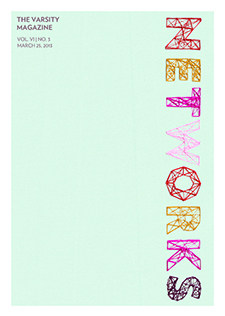Table of Contents
Networks Magazine Mix
Letter from the Editor
Visualizing Networks
The Magazine Team
Parents, community, hip hop
Their Winnipeg
Dance and dedication
Outside the homeland, inside the community?
Finding the right piece
Mechanical mind meld
Endless highway
Patchwork (illustration)
The web grows up
Mistaken culinary identity
Sorting it out
Rewriting your favourite universe
Getting the neurons firing
What’s a punk like you doing in a place like this?
Ocean Ecosystems: Dark Precursor Project
Sleeping with strangers
The Network Magazine Mix

Simon Frank Varsity Magazine Editor, 2012–2013
There were some points when this magazine was on unsteady ground. By the beginning of March a certain mania sets in at U of T, and students either hunker down with their work or do everything possible to avoid it. To get content for this magazine, we looked far and wide, holding the standard pitch meeting, but also reaching out to younger writers, and emailing old friends who left Toronto long ago but have a special perspective on certain topics. To finish their pieces, our writers matched our efforts, phoning distant relatives, contacting artists they’ve been following online but had never met, and sending queries to U of T professors. On the visual side, associate design editor Nathan Watson asked his dad to drive over a piece for drywall from his hometown of Welland, Ontario, which served as the basis for our nail-and-string cover art.
The point is that we wouldn’t have been able to do this without the networks around us. Friends, family, the university, the city, and broader ethnic or cultural communities: we all exist as a link in each of these networks. Within them we stay informed, get and give support, meet new people, and sometimes even argue. Currently, the word ‘networks’ brings with it the immediate association of social networks, but it’s important to remember these websites and programs are centered around the age-old idea of communication, just as easily accomplished face-to-face.
With that in mind, the articles that follow examine networks ranging from ancient to hyper-modern. Murad Hemmadi looked into his own background to explore how India’s Parsi community is being shaped by immigration , while Katrina Vogan focused on the future in her investigation of the networks that could be created by new Brain-Machine Interference technology . Elsewhere, writers captured how networks can combine the past with the present, as traditional communities start to communicate on computers and smartphones. As seen in Damanjit Lamba’s piece on the GTA’s Punjabi rappers, communities may shift locations and evolve with the times, but something remains stable in their networks and core identity.
Of course, the network at the heart of this magazine is The Varsity’s editors and staff. This is my last magazine as editor, so I’d like to expressly thank all of you. Each issue and magazine wouldn’t be possible without your hard work. Thanks also to our readers, who I sincerely hope extend beyond my parents…
— Simon Frank, Varsity Magazine Editor, 2012–2013
Visualizing networks
 Our job is to reveal without distracting. Design is always present, but its job is to connect the reader (or viewer, or listener, or user — you get the idea) to the content being presented. It’s invisible in the sense that design, at its best, becomes one with content.
Our job is to reveal without distracting. Design is always present, but its job is to connect the reader (or viewer, or listener, or user — you get the idea) to the content being presented. It’s invisible in the sense that design, at its best, becomes one with content.
At first glance the idea of a network is one that may seem easy to conceptualize in terms of design. Make a couple dots, draw a couple of lines, and you’re done. But that’s lazy thinking. While those things can be part of a visualization of networks (hell, our cover uses them, and it’s goddamn beautiful), dots and lines alone aren’t enough.
Designing for networks thoughtfully means doing much more than representing connections. It means showing what’s behind them, helping make clear how they form and break, demonstrating when they’re good and when they’re bad. It’s about becoming invisible, and in doing so making what’s invisible about networks apparent.
—The Design Team Varsity Magazine, 2012–2013
The Magazine Team



